How to create a financial forecast for an auto equipment store?
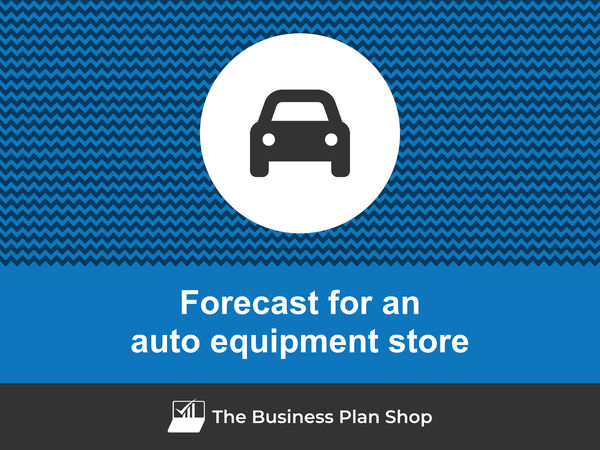
Creating a financial forecast for your auto equipment store, and ensuring it stays up to date, is the only way to maintain visibility on future cash flows.
This might sound complex, but with the right guidance and tools, creating an accurate financial forecast for your auto equipment store is not that hard.
In this guide, we'll cover everything from the main goal of a financial projection, the data you need as input, to the tables that compose it, and the tools that can help you build a forecast efficiently.
Without further ado, let us begin!
Why create and maintain a financial forecast for an auto equipment store?
Creating and maintaining an up-to-date financial forecast is the only way to steer the development of your auto equipment store and ensure that it can be financially viable in the years to come.
A financial plan for an auto equipment store enables you to look at your business in detail - from income to operating costs and investments - to evaluate its expected profitability and future cash flows.
This gives you the visibility needed to plan future investments and expansion with confidence.
And, when your trading environment gets tougher, having an up to date auto equipment store forecast enables you to detect potential upcoming financing shortfalls in advance, enabling you to make adjustments or secure financing before you run out of cash.
It’s also important to remember that your auto equipment store's financial forecast will be essential when looking for financing. You can be 100% certain that banks and investors will ask to see your numbers, so make sure they’re set out accurately and attractively.
Need a solid financial forecast?
The Business Plan Shop does the maths for you. Simply enter your revenues, costs and investments. Click save and our online tool builds a three-way forecast for you instantly.

What information is used as input to build an auto equipment store financial forecast?
A auto equipment store's financial forecast needs to be built on the right foundation: your assumptions.
The data required to create your assumptions will depend on whether you are a new or existing auto equipment store.
If you are creating (or updating) the forecast of an existing auto equipment store, then your main inputs will be historical accounting data and operating metrics, and your team’s view on what to expect for the next three to five years.
If you are building financial projections for a new auto equipment store startup, you will need to rely on market research to form your go-to-market strategy and derive your sales forecast.
For a new venture, you will also need an itemised list of resources needed for the auto equipment store to operate, along with a list of equipment required to launch the venture (more on that below).
Now that you understand what is needed, let’s have a look at what elements will make up your auto equipment store's financial forecast.
The sales forecast for an auto equipment store
From experience, it is usually best to start creating your auto equipment store financial forecast by your sales forecast.
To create an accurate sales forecast for your auto equipment store, you will have to rely on the data collected in your market research, or if you're running an existing auto equipment store, the historical data of the business, to estimate two key variables:
- The average price
- The number of monthly transactions
To get there, you will need to consider the following factors:
- Seasonal Demand: As the owner of an auto equipment store, you are well aware that certain seasons see a higher demand for specific products. For example, during winter months, there may be an increase in demand for snow tires and antifreeze, while summer months may see a surge in requests for air conditioning systems and car batteries. Keeping track of seasonal demand patterns can help you forecast the average price and number of monthly transactions for your business.
- Technological Advancements: With the constant advancements in technology, new and improved auto equipment is being introduced in the market regularly. This can affect your business's average price, as customers may be willing to pay more for the latest and most advanced products. Additionally, the introduction of new products may also attract more transactions from customers who are looking for the latest and best options for their vehicles.
- Competition: The presence of competitors in the market can also impact your business's average price and monthly transactions. If there are other auto equipment stores in the area offering similar products, you may need to adjust your prices to stay competitive. Similarly, if a new competitor enters the market, it may lead to a decrease in your average price and a potential loss of transactions as customers may opt for the newer option.
- Economic Conditions: Economic conditions, such as inflation, interest rates, and consumer spending, can also influence your business's sales forecast. During times of economic downturn, customers may be more price-sensitive and opt for lower-priced products, leading to a decrease in your average price and number of transactions. On the other hand, during periods of economic growth, customers may be more willing to spend on higher-priced products, leading to an increase in your business's average price and monthly transactions.
- Vehicle Trends: The type of vehicles that are popular among customers can also impact your business's sales forecast. For instance, an increase in the demand for electric or hybrid vehicles may lead to a decrease in the demand for traditional auto equipment, affecting your average price and monthly transactions. Staying updated with the latest vehicle trends can help you anticipate any potential changes in your business's sales forecast.
Once you have an idea of what your future sales will look like, it will be time to work on your overhead budget. Let’s see what this entails.
Need inspiration for your business plan?
The Business Plan Shop has dozens of business plan templates that you can use to get a clear idea of what a complete business plan looks like.

The operating expenses for an auto equipment store
The next step is to estimate the costs you’ll have to incur to operate your auto equipment store.
These will vary based on where your business is located, and its overall size (level of sales, personnel, etc.).
But your auto equipment store's operating expenses should normally include the following items:
- Staff costs: Salaries, bonuses, benefits, and training expenses for your employees, including salespeople, technicians, and administrative staff.
- Accountancy fees: Expenses for hiring an accountant or accounting firm to handle your financial records, taxes, and other financial matters.
- Insurance costs: Premiums for different types of insurance coverage, such as liability insurance, property insurance, and workers' compensation insurance.
- Software licenses: Fees for purchasing and renewing software licenses for programs used in your store, such as inventory management software, accounting software, and point-of-sale systems.
- Banking fees: Charges for using banking services, such as deposit fees, withdrawal fees, and transaction fees.
- Rent: Monthly payment for leasing the space where your store is located.
- Utilities: Expenses for electricity, water, gas, and other utilities used in your store.
- Advertising and marketing: Costs for promoting your store and its products through various channels, such as print ads, online ads, and social media ads.
- Inventory: Expenses for purchasing and restocking your inventory of auto equipment, tools, and supplies.
- Maintenance and repairs: Costs for maintaining and repairing your store equipment and facilities, such as HVAC systems, computers, and shelves.
- Professional fees: Fees for hiring consultants, lawyers, or other professionals for specific projects or services.
- Office supplies: Expenses for purchasing paper, pens, printer ink, and other supplies needed for day-to-day operations.
- Employee benefits: Costs for providing benefits to your employees, such as health insurance, retirement plans, and paid time off.
- Delivery and shipping: Expenses for delivering or shipping products to customers, as well as receiving shipments from suppliers.
- Waste disposal: Fees for disposing of waste and recycling materials generated by your store.
This list is not exhaustive by any means, and will need to be tailored to your auto equipment store's specific circumstances.
What investments are needed to start or grow an auto equipment store?
Creating and expanding an auto equipment store also requires investments which you need to factor into your financial forecast.
Capital expenditures and initial working capital items for an auto equipment store could include elements such as:
- Automotive Lifts: These are essential for an auto equipment store as they allow you to easily lift and maneuver vehicles for repairs and maintenance. They come in various sizes and weight capacities, so make sure to choose ones that suit your specific needs.
- Diagnostic Equipment: In order to accurately diagnose and troubleshoot vehicle issues, you will need to invest in high-quality diagnostic equipment. This may include scanners, code readers, and other specialized tools.
- Air Compressor: An air compressor is necessary for powering pneumatic tools such as impact wrenches, air hammers, and air ratchets. Choose a compressor with enough power and capacity to handle your shop's needs.
- Tire Changer and Balancer: For an auto equipment store that offers tire services, having a tire changer and balancer is a must. These machines make it easier and faster to change and balance tires, saving you time and effort.
- Alignment Machine: An alignment machine is crucial for ensuring that vehicles' wheels are properly aligned, which is essential for safe and efficient driving. Choose a machine that can handle a variety of vehicle sizes and types.
Again, this list is not exhaustive and will need to be adjusted according to the circumstances of your auto equipment store.
Need a convincing business plan?
The Business Plan Shop makes it easy to create a financial forecast to assess the potential profitability of your projects, and write a business plan that’ll wow investors.

The financing plan of your auto equipment store
The next step in the creation of your financial forecast for your auto equipment store is to think about how you might finance your business.
You will have to assess how much capital will come from shareholders (equity) and how much can be secured through banks.
Bank loans will have to be modelled so that you can separate the interest expenses from the repayments of principal, and include all this data in your forecast.
Issuing share capital and obtaining a bank loan are two of the most common ways that entrepreneurs finance their businesses.
What tables compose the financial plan for an auto equipment store?
Now let's have a look at the main output tables of your auto equipment store's financial forecast.
The projected profit & loss statement
The projected profit & loss shows how profitable your auto equipment store is likely to be in the years to come.
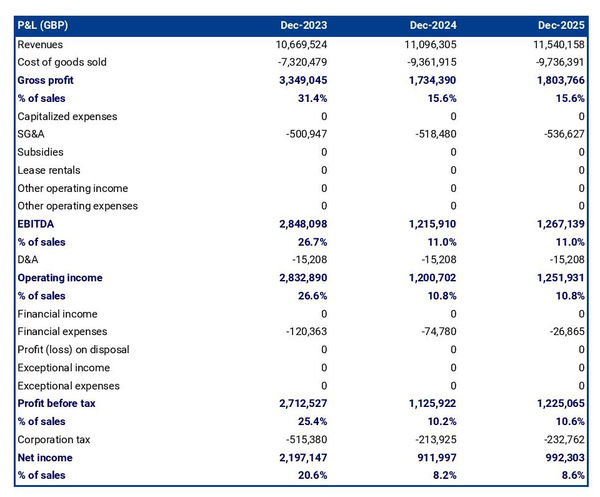
For your auto equipment store to be financially viable, your projected P&L should ideally show:
- Sales growing above inflation (the higher the better)
- Profit margins which are stable or expanding (the higher the better)
- A net profit at the end of each financial year (the higher the better)
This is for established auto equipment stores, there is some leniency for startups which will have numbers that will look a bit different than existing businesses.
The projected balance sheet
Your auto equipment store's projected balance sheet provides a snapshot of your business’s financial position at year-end.
It is composed of three types of elements: assets, liabilities and equity:
- Assets: represent what the business possesses including cash, equipment, and accounts receivable (money owed by clients).
- Liabilities: represent funds advanced to the business by lenders and other creditors. They include accounts payable (money owed to suppliers), taxes payable and loans from banks and financial institutions.
- Equity: is the combination of what has been invested by the business owners and the cumulative profits and losses generated by the business to date (which are called retained earnings). Equity is a proxy for the value of the owner's stake in the business.
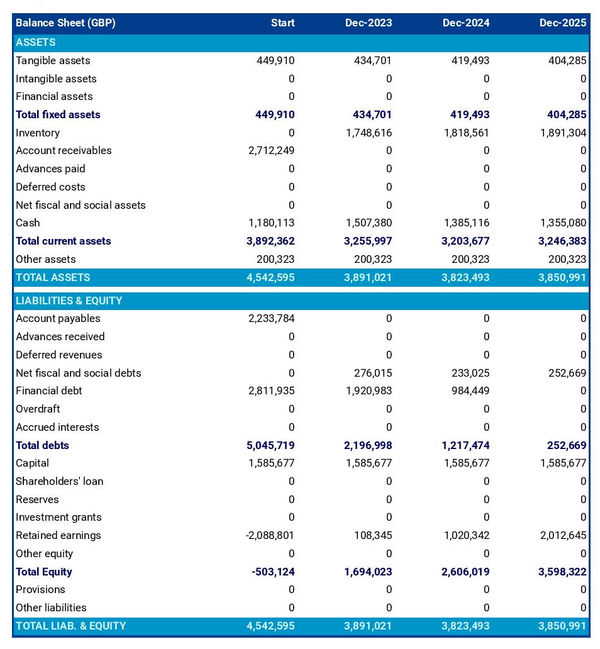
The cash flow projection
The cash flow forecast of your auto equipment store will show how much cash the business is expected to generate or consume over the next three to five years.
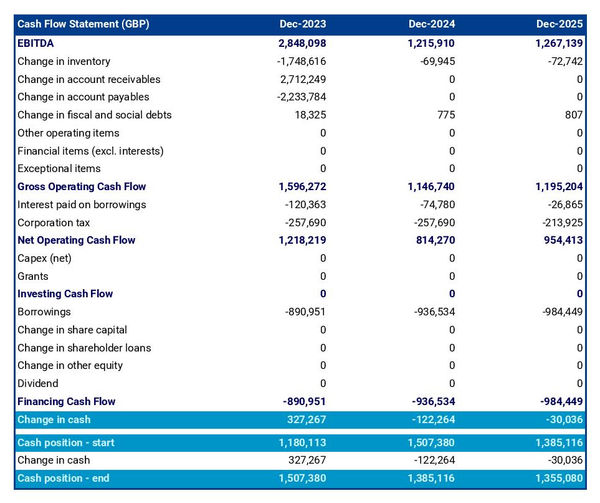
There are multiple ways of presenting a cash flow forecast but from experience, it is better to organise it by nature in order to clearly show these elements:
- Operating cash flow: how much cash is generated by the auto equipment store's operations
- Investing cash flow: what is the business investing to expand or maintain its equipment
- Financing cash flow: is the business raising additional funds or repaying financiers (debt repayment, dividends)
Your cash flow forecast is the most important element of your overall financial projection and that’s where you should focus your attention to ensure that your auto equipment store is adequately funded.
Note: if you are preparing a financial forecast in order to try to secure funding, you will need to include both a yearly and monthly cash flow forecast in your auto equipment store's financial plan.
Need a solid financial forecast?
The Business Plan Shop does the maths for you. Simply enter your revenues, costs and investments. Click save and our online tool builds a three-way forecast for you instantly.

Which tool should you use to create your auto equipment store's financial forecast?
Using the right tool or solution will make the creation of your auto equipment store's financial forecast much easier than it sounds. Let’s explore the main options.
Using online financial forecasting software to build your auto equipment store's projections
The modern and easiest way is to use an online financial forecasting tool such as the one we offer at The Business Plan Shop.
There are several advantages to using specialised software:
- You can easily create your financial forecast by letting the software take care of the financial calculations for you without errors
- You have access to complete financial forecast templates
- You get a complete financial forecast ready to be sent to your bank or investors
- You can easily track your actual financial performance against your financial forecast, and recalibrate your forecast as the year goes by
- You can create scenarios to stress test your forecast's main assumptions
- You can easily update your forecast as time goes by to maintain visibility on future cash flows
- You have a friendly support team on standby to assist you when you are stuck
- It’s cost-efficient and much cheaper than using an accountant or consultant (see below)
If you are interested in this type of solution, you can try our projection software for free by signing up here.
Calling in a financial consultant or chartered accountant
Enlisting the help of a consultant or accountant is also a good way to obtain a professional auto equipment store financial forecast.
The downside of this solution is its cost. From experience, obtaining a simple financial forecast over three years (including a balance sheet, income statement, and cash flow statement) is likely to cost a minimum of £700 or $1,000.
The indicative cost above, is for a small business, and a forecast is done as a one-shot exercise. Using a consultant or accountant to track your actuals vs. forecast and to keep your financial projections up to date on a monthly or quarterly basis will cost a lot more.
If you opt for this solution, make sure your accountant has in-depth knowledge of your industry, so that they may challenge your figures and offer insights (as opposed to just taking your assumptions at face value to create the forecast).
Why not use a spreadsheet such as Excel or Google Sheets to build your auto equipment store's financial forecast?
Creating an accurate and error-free auto equipment store financial forecast on Excel (or any spreadsheet) is very technical and requires both a strong grasp of accounting principles and solid skills in financial modelling.
Most entrepreneurs lack the expertise required to create an accurate financial forecast using spreadsheet software like Excel or Google Sheets. As a result, it is unlikely anyone will trust your numbers.
The second reason is that it is inefficient. Building forecasts on spreadsheets was the only option in the 1990s and early 2000s, nowadays technology has advanced and software can do it much faster and much more accurately.
This is why professional forecasters all use software. With the rise of AI, software is also becoming smarter at helping us detect mistakes in our forecasts and helping us analyse the numbers to make better decisions.
Finally, like everything with spreadsheets, tracking actuals vs. forecasts and updating your forecast as the year progresses is manual, tedious, error-prone, and time-consuming. Whereas financial forecasting software like The Business Plan Shop is built for this.
Need a convincing business plan?
The Business Plan Shop makes it easy to create a financial forecast to assess the potential profitability of your projects, and write a business plan that’ll wow investors.

Use our financial projection templates for inspiration
The Business Plan Shop has dozens of financial forecasting templates available.
Our examples contain both the financial forecast, and a written business plan which presents, in detail, the company, the team, the strategy, and the medium-term objectives.
Whether you are just starting out or already have your own auto equipment store, looking at our template is always a good way to get ideas on how to model financial items and what to write when creating a business plan to secure funding.
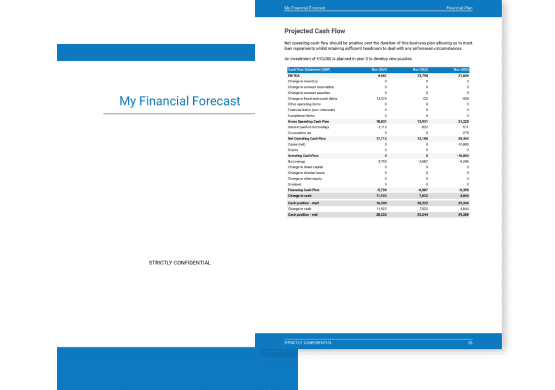
Takeaways
- A financial projection shows expected growth, profitability, and cash generation for your business over the next three to five years.
- Tracking actuals vs. forecast and keeping your financial forecast up-to-date is the only way to maintain visibility on future cash flows.
- Using financial forecasting software makes it easy to create and maintain up-to-date projections for your auto equipment store.
You have reached the end of our guide. We hope you now have a better understanding of how to create a financial forecast for an auto equipment store. Don't hesitate to contact our team if you have any questions or want to share your experience building forecasts!
Need inspiration for your business plan?
The Business Plan Shop has dozens of business plan templates that you can use to get a clear idea of what a complete business plan looks like.

Also on The Business Plan Shop
Know someone who runs or wants to start an auto equipment store? Share our financial projection guide with them!




